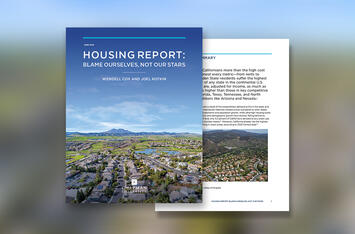
No issue plagues Californians more than the high cost of housing. By almost every metric—from rents to home prices—Golden State residents suffer the highest burden for shelter of any state in the continental U.S. Its housing prices are, adjusted for income, as much as two to three times higher than those in key competitive states, such as Florida, Texas, Tennessee, and North Carolina, and neighbors like Arizona and Nevada.
Some claim these high prices are a result of the extraordinary demand to live in the state, and its limited land. Yet California maintained relatively modest prices compared to other states during its period of most rapid economic and population growth, while ultra-high housing costs emerged as the state’s economic and demographic growth have slowed, falling behind its prime competitors. In terms of land, only 5.0 percent of California is devoted to any urban use, less than any of the Northeast Corridor states. Moreover, California already has the highest percentage of its population living in urban areas, according to 2020 Census data.
The problem, to paraphrase Shakespeare, lies not in our stars but in ourselves—or, more precisely, our policy choices.
For the better part of the last few decades, California policy makers have increasingly steered housing development away from peripheral locations, where land is cheaper and local regulations generally less strict, seeking to drive growth to dense urban areas, where costs are higher and regulatory environments generally more difficult to navigate.
This effort has failed completely. The very places that policy makers seek to burden with more regulation, including most notably the Inland Empire and Central Valley, have grown, while the favored big cities have stagnated. Both the city and county of Los Angeles, California’s largest urban area, have fewer residents today than in 2010. Clearly, the state needs a housing policy that can still address environmental concerns while also meeting the aspirations of California’s new, and more diverse, population. California needs once again to do what it has long done: innovate and accommodate new generations of workers and families.
Download/read the full report here (PDF, 5.6MB opens in new tab or window)
Joel Kotkin is the author of The Coming of Neo-Feudalism: A Warning to the Global Middle Class. He is the Roger Hobbs Presidential Fellow in Urban Futures at Chapman University and Executive Director for Urban Reform Institute. Learn more at joelkotkin.com and follow him on Twitter @joelkotkin.
Wendell Cox is principal of Demographia (St. Louis, MO-IL), a demographics and public policy firm. He was appointed by Mayor Tom Bradley to three terms on the Los Angeles County Transportation Commission, which was a predecessor to the Los Angeles County MTA. Speaker Newt Gingrich appointed him to the Amtrak Reform Council. He specializes in demographics and urban affairs. He is co-author of the Demographia International Housing Affordability Survey and author of Demographia World Urban Areas, A Question of Values: Middle-Income Housing Affordability and Urban Containment Policy, Canada’s Middle-Income Housing Affordability Crisis, and the Urban Reform Institute Standard of Living Index. He is a senior fellow at member of the Board of Advisors at the Center for Demographics and Policy at Chapman University, the Urban Reform Institute (Houston) and the Frontier Centre for Public Policy (Winnipeg).












